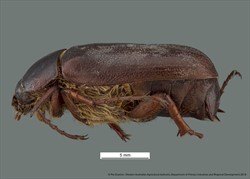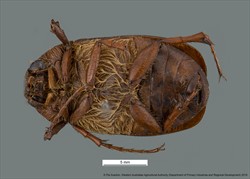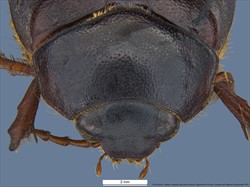Sub family: Melolonthinae / Tribe: Melolonthini / Genus: Phyllophaga
Fact Sheet
Phyllophaga Harris, 1827
Medium to large oval or cylindrical beetles, body length 8-25mm. Body colouration commonly brown to reddish brown, rarely blackish. Antennae usually 9-10 segmented (rarely 8), with a 3-segmented club. Clypeus usually with an emarginate apex. Labrum located under clypeus, clearly separated and deeply incised medially. Pronotum wider than long, lacking a membraneous anterior margin. Anterior coxae transverse, flattened. Metepisternum narrow. Pygidium large. Metatibial spurs both moveable in some species, in others both moveable only in females, 1 moveable in males. Tarsal claws cleft or toothed. Usually with a smooth inner surface, rarely pectinate/serrate.
Male genitalia has been seen as the most useful means of species level identification. Woodruff and Beck (1989) describe the morphological features and their complexity for the known Florida species.
Larvae of Phyllophaga feed on the roots of a large range of plants and grasses. Adult beetles feed on plant foliage, and can cause significant damage when mass emergences occur. Both forms can have severe impacts on a large number of cultivated crops including maize, sorghum, wheat, rye, beans, oat, potato, sugarcane, turnip and cranberry. They can also be a significant pest of pastures and turf. Most adults emerge late spring/ early summer. Adults are nocturnal, and attracted to light. Night feeding beetles are not easily disturbed, leading to easy collection from their host plants.
Among the recognised pest species to Australia are: P. anxia, P. crinita, P. ephilida, P. elenans, P. fusca, P. implicita, P. menetriesii, and P. vicina. Ratcliffe and Paulson (2008) provide a key to Nebraskan species covering many of these important pests, and Woodruff and Beck (1989) cover the species of Florida. Genitalia illustrations and larval keys for Central American species has been covered by King (1984).
Phyllophaga are absent from Australia. They are distributed across North, Central and South America.
University of Nebraska State Museum - Guide to Phyllophaga, including 10 species profile pages : http://unsm-ento.unl.edu/Guide/Scarabaeoidea/Scarabaeidae/Melolonthinae/Melolonthinae-Generic-pages/Melolonthini/Phyllophaga/Phyllophaga.html
PHA Threat Specific Contingency Plan for Phyllophaga: http://www.planthealthaustralia.com.au/wp-content/uploads/2013/03/May-beetle-CP-2008.pdf
Phyllophaga ephilida Hawaiian Scarab ID fact sheet: http://idtools.org/id/beetles/scarab/factsheet.php?name=15215
May Beetles of the United States and Canada (Luginbill & Painter, 1953) full PDF (Warning Large! 52mb): https://naldc.nal.usda.gov/download/43418/PDF
Review of the tribe Melolonthini in the southeastern United States (Coleoptera: Scarabaeidae: Melolonthinae) (Skelley, 2003) Full PDF (Warning Large! 38mb): http://journals.fcla.edu/mundi/article/view/25029/24360
King, A.B.S. 1984. Biology and identification of white grubs (Phyllophaga) of economic importance in Central America. Tropical Pest Management 30: 36-50
Luginbill, P., Painter, H.R. 1953. May beetles of the United. States and Canada. Tech. Bull. 1060. USDA, Washington. 102 pp.
Ratcliffe, B.C., Paulsen, M.J. 2008. The Scarabaeoid Beetles of Nebraska. Bulletin of the University of Nebraska State Museum 22: 570 pp.
Woodruff, R.E., Beck, B.M. 1989. The scarab beetles of Florida (Coleoptera: Scarabaeidae) Part II, The May or June beetles (Genus Phyllophaga). Florida Department of Agriculture and Consumer Services, Arthropods of Florida and neighboring Land Areas vol. 13. vi. 226 pp.







